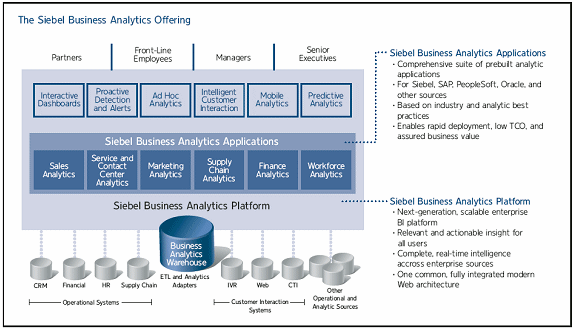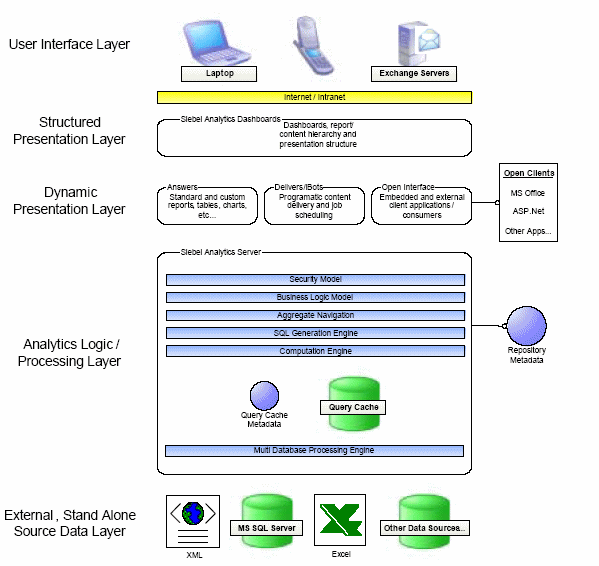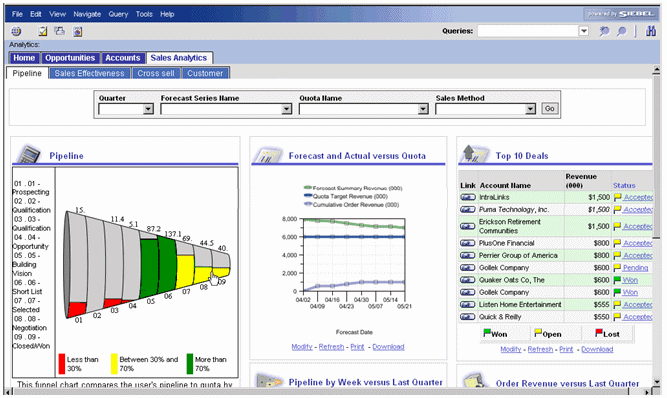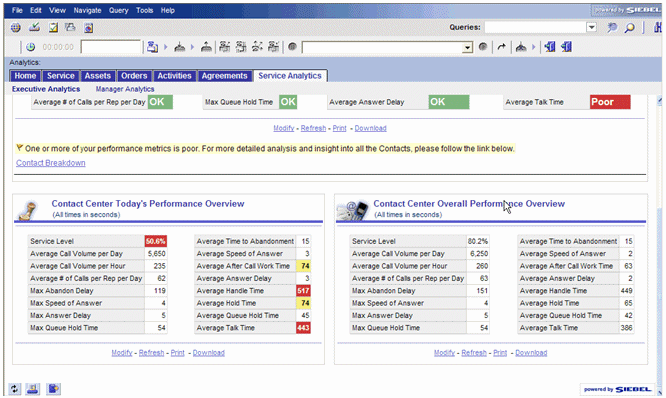Siebel Analytics - The Jewel in the Project Fusion Crown?
As the proposed Oracle purchase of Siebel draws closer, and Oracle announce that they're half way there to producing the first Fusion applications, it's worth taking a look at what could perhaps be the jewel in the set of technology that Oracle has purchased, the business intelligence element of Siebel's product line known as "Siebel Analytics".
Siebel Analytics is a business intelligence platform build on a Service Orientated Architecture (SOA) that is usually run alongside Siebel CRM, but can also be run standalone. Siebel Analytics consists of two main product lines, the first of which is Siebel Business Analytics Applications, a set of industry-specific applications such as "Sales Analytics", "Marketing Analytics" and "Supply Chain Analytics" that are analogous to the old Oracle Sales Analyzer and Oracle Financial Analyzer products, and the Enterprise Planning & Budgeting and other CPM products that Oracle now offer. There are also options for building custom dashboards, doing ad-hoc analysis and doing predictive analytics using a Siebel data mining engine.


I'll say at this point that I've never worked with Siebel Analytics and so what I'm reporting on is what I've managed to pick up from Siebel's site and those of it's partners. In the above diagram, taken from a Microsoft document on tuning Siebel Analytics on SQL Server, it looks like this server layer contains an OLAP-style calculation engine, aggregate navigation facilities, an engine to generate SQL queries and a security model. The way that the Analytic Server appears to work is that it receives queries from a front-end tool - either Siebel's own products or a third-party tool via the ODBC link - and then firsts checks to see whether the query can be met from it's own internal cache. If it can't, it then issues SQL to the relevant data source, which can be Oracle, SQL Server, DB2 or other relational data sources, or it can be to any OLAP server that can understand MDX or XML/A - primarily, Microsoft's Analysis Services. Once the data is retrieved, it goes into the cache and can then be used to satisfy the same query if it's requested again.
In order to speed up queries before the user gets around to requesting the data, you can use something called "iBots" to pre-seed the cache in advance and speed up important queries. In the Microsoft document it talks about pre-seeding the cache with the data required to populate all the users' dashboards, bringing average response time down to a few seconds, and with lots of users this cache can grown up to several gigabytes in size. The obvious analogies here are with Oracle's Materialized View and Analytic Workspace technologies, but this seems a bit more advanced in that the server will go off and cache data for you if you've not previously generated a prebuilt summary, and it would be interesting to know how well the iBot approach compares to the various summary advisors you get with Oracle Database 10g and Oracle Discoverer Administrator. Of course Microsoft have taken this approach one step further with Analysis Services 2005, where the database engine will go an pro-actively cache and summarise the relational dataset after you have defined an OLAP cube, so that the data should be pre-summarised even before the user goes to query the data, and the administrator doesn't have to go off an explicitely set up routines to pre-cache or pre-seed the database.
The other obvious analogy is with SAP's Business Warehouse. It too has it's own OLAP-style calculation engine, it's own data model and it's own APIs to support third-party access, and even Cognos are getting in on this approach with Cognos ReportNet, which works off of a star schema-style data model and caches data in the background. It's what Oracle are getting at with Discoverer - which has a server-side cache of data which it then pivots and indexes - and the OLAP Option, which sucks in data from relational tables and then makes it available for querying - but Siebel seem to have a much more complete set of products here, although as I said I've not worked with it myself so I can't offer any opinions as to whether it actually works as advertised.
Once you've got your data into Siebel Analyics Server, you can then use Siebel's range of vertical applications to query your data. One example is Siebel Sales Analytics, which has a browser-based interface that looks like this:

I'm aware that it runs in Microsoft Internet Explorer, I don't know about support for any other browsers or whether it uses DHTML, a Java applet or something like Active-X. The server products appear to be supported on both Unix and Windows but I don't know about the front-end, the only details I can find are about a deployment on Windows Server 2003 along with IIS6.0 and the .NET Framework. The obvious comparison again here is with Oracle's Daily Business Intelligence - they both appear to be solving the same problem, Oracle's approach is more "HTML-style" whereas Siebel's is more like a desktop application. Another prebuilt application is Siebel Contact Centre Analytics, which takes a slightly less OLAP-style approach and is more about KPIs and alerts:

So, I wonder what will happen to Siebel Analytics once the Oracle takeover happens? One would presume that some of this technology will make it's way into the Fusion platform, but there would appear to be some overlap between what Siebel have achieved and what Oracle are currently offering with Discoverer, Oracle OLAP, Materialized Views and Daily Business Intelligence / Enterprise Planning & Budgeting. Certainly I remember being at Open World last year and someone asking in Ray Roccoforte's "Oracle BI Futures" presentation, what would be happening with Siebel Analytics, and its certainly interesting to contrast Siebel Analytics user community, who appear to be very satisfied with the performance of the product, with the Discoverer user community, who in the recent OLAP Survey had the highest percentage of respondents who reported bad query performance. It'll be interesting to see if any of the Siebel Analytics technologies make it into the Fusion product line, or indeed into the summary management parts of any future Oracle database release. We'll have to wait and see.
If you've any experiences in working with Siebel Analytics, add a comment to this blog posting as I'd be interested in getting some real-world feedback. Until then, here's some further reading: